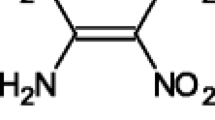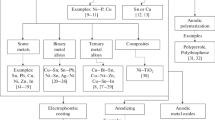Abstract
Anodic oxidation of dimethyl sulfoxide (DMSO) based electrolyte solutions, containing LiClO4, LiBF4 and KPF6, on platinum (Pt), glassy carbon (GC) andn-TiO2 (anatase), electrodes was studied usingin situ Fourier transform infrared spectroscopy (FTIR). All solutions contained small amounts of H2O. Regardless of the supporting electrolyte all systems were unstable at potentials above 1.0 V vs SCE. The major oxidation product is dimethyl sulfone, formation of which is initiated by the trace water breakdown. In contrast to acetonitrile based solutions there is no evidence of electrolyte involvement in the breakdown process. Photoanodic decomposition of dimethyl sulfoxide based solutions proceeds in the same way as the anodic oxidation in the dark. In the presence of nucleophilic agent (iodides) the prevailing redox process is iodide oxidation. Small amounts of, probably, methylsulfinyliodide are also formed. The irreversible consumption of charge mediator significantly restricts the possible practical use of DMSO in photoelectrochemical devices.
Similar content being viewed by others
References
T. Nagatomo, M. Mitsui, K. Matsutani and O. Omoto,Trans. Inst. Electron. Inf. Commun. Eng. E70, (1987) 346.
B. O'Regan and M. Grätzel,Nature,353 (1991) 737.
L. Kavan, A. Kay, B. O'Regan and M. Grätzel,J. Electroanal. Chem. 346 (1993) 291.
C. K. Mann,Electroanal. Chem. vol. 3 (edited by A. J. Bard), Marcel Dekker, New York (1969).
N. L. Wienbergin ‘Technique of Electroorganic Synthesis’, J. Wiley & Sons, New York (1974) p. 29.
G. J. Janz and R. P. T. Tomkins, ‘Nonaqueuous Electrolytes Handbook’, vol 2, Academic Press, New York (1972).
R. J. Burris, PhD thesis, University of Tennesse, Knoxville (1962).
J. L. Jones and H. A. Fritsche,J. Electroanal. Chem. 12 (1966) 334.
M. C. Giordano, J. C. Baran and A. J. Arvia,Electrochim. Acta 11 (1966) 741.
E. Yu. Alekseeva, V. A. Safonov and O. A. Petrii,Elektrokhimia 18 (1982) 1290.
H. Gampp and S. J. Lippard,Inorg. Chem. 22 (1983) 357.
R. L. Bartzatt and J. Carr,Transition. Met Chem. 11 (1986) 116.
M. J. Davies, B. C. Gilbert and R. O. C. Norman,J. Chem. Soc. Perkin Trans. 2 (1984) 503.
L. Kavan, P. Krtil and M. Grätzel,J. Electroanal. Chem. 373 (1994) 123.
P. Krtil, L. Kavan and P. Novák,J. Electrochem Soc. 140 (1993) 3390.
L. Kavan and M. Grätzel,Electrochim. Acta 40 (1995) 643.
A. Bewick and S. Pons,in ‘Advances in Infrared and Raman Spectroscopy’, vol. 12 (edited by R. J. H. Clark and R. E. Hester), J. Wiley & Sons, Heyden (1985) p. 1.
P. A. Christensen and A. Hamnett,in ‘Comprehensive Chemical Kinetics’, vol. 29 (edited by R.G. Compton and A. Hammett), Elsevier, Amsterdam (1989) p. 1.
J. K. Foley, C. Krozeniewski and S. Pons,Canad. J. Chem. 66 (1988) 201.
W. T. King and B. L. Crawford,J. Mol. Spectroscopy. 5 (1960) 421.
J. H. Carter, J. M. Freeman and T. Henshall,J. Mol. Spectroscopy 20 (1966) 402.
G. Socrates, ‘Infrared Characteristic Group Frequencies’, J. Wiley & Sons, Chichester, UK (1980) p. 112.
S. D. Ross, ‘Inorganic Infrared and Raman Spectra’ McGraw-Hill, London (1971).
S. R. Polo and M. K. Wilson,J. Chem. Phys. 22 (1954) 900.
J. G. David, H. E. Hallam,Spectrochim. Acta 23A (1967) 593.
Author information
Authors and Affiliations
Rights and permissions
About this article
Cite this article
Krtil, P., Kavan, L., Hoskovcová, I. et al. Anodic oxidation of dimethyl sulfoxide based electrolyte solutions: Anin situ FTIR study. J Appl Electrochem 26, 523–527 (1996). https://doi.org/10.1007/BF01021976
Received:
Revised:
Issue Date:
DOI: https://doi.org/10.1007/BF01021976




